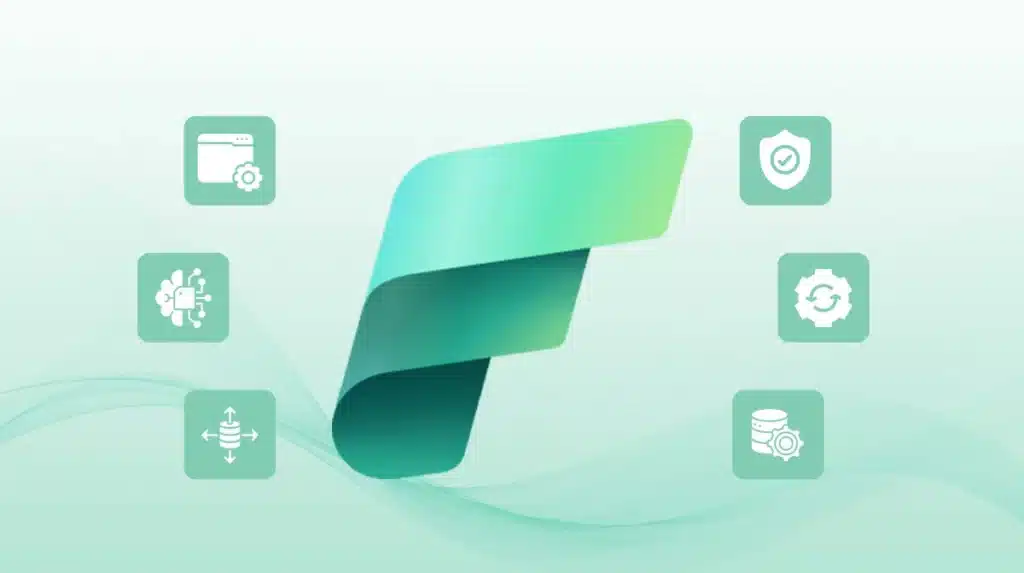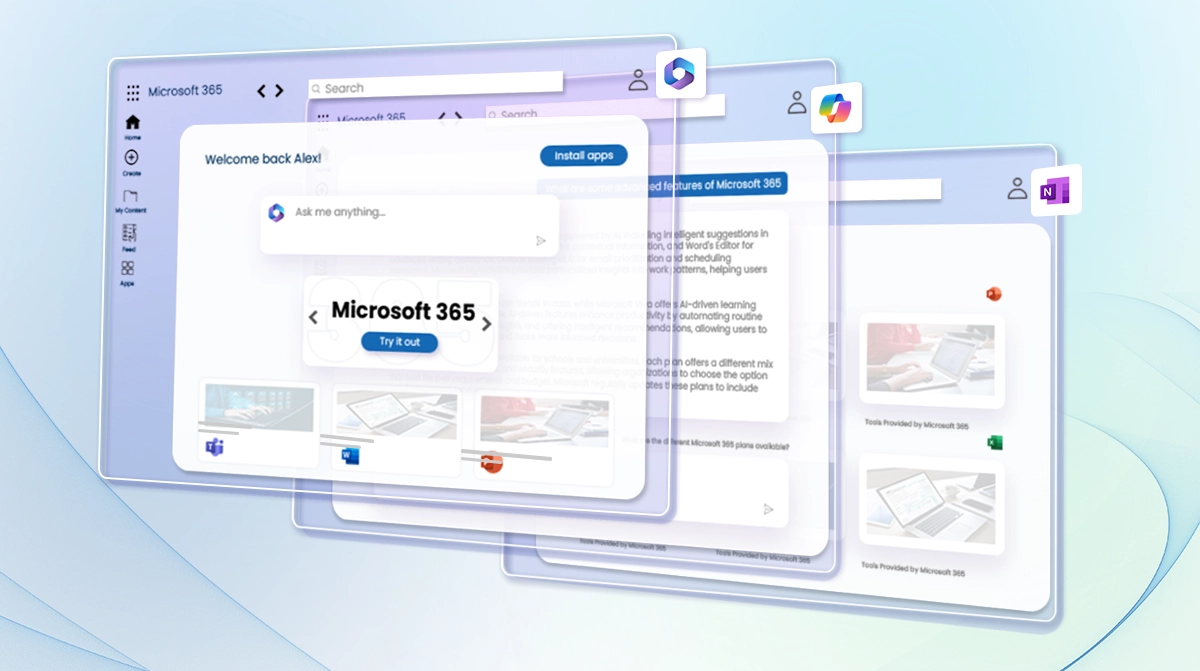In a world where data is the new currency, businesses are drowning in disconnected sources, scattered tools, and the constant pressure to make sense of it all instantly. Spreadsheets aren’t cutting it, and traditional BI systems feel like patchwork solutions. What organizations need is a smarter, faster, and unified approach to data analytics. That’s where Microsoft Fabric steps in, not as another tool but as a complete transformation.
This revolutionary SaaS platform brings together the best of Microsoft Power BI Consulting Services, Azure Synapse Analytics, and Data Factory into a seamless, all-in-one analytics powerhouse. From raw data to refined insight, from engineering to executive dashboards—Fabric does it all in one place. It’s not just about better reporting; it’s about empowering every team to work smarter with data, eliminating silos, and unlocking real-time intelligence. Microsoft Fabric isn’t just keeping up with the future of analytics—it’s building it.
The Genesis of Microsoft Fabric
Microsoft Fabric was conceived to address the complexities of modern data analytics. Traditionally, businesses relied on disparate tools for data ingestion, transformation, storage, and visualization. This fragmented approach often led to inefficiencies, data silos, and increased operational costs. Recognizing these challenges, Microsoft introduced Fabric—a unified platform that consolidates various data analytics components, streamlining workflows and fostering collaboration across teams.
Core Components of Microsoft Fabric: A Symphony of Unified Analytics
Microsoft Fabric isn’t just another analytics tool—it’s a powerful platform meticulously designed to eliminate complexity, foster collaboration, and turn raw data into real-time business intelligence. At its core are five standout components that work in harmony, offering a seamless data journey from integration to visualization. Here’s a deep dive into what makes Fabric not just functional, but revolutionary.
1. OneLake: The Unified Data Lake
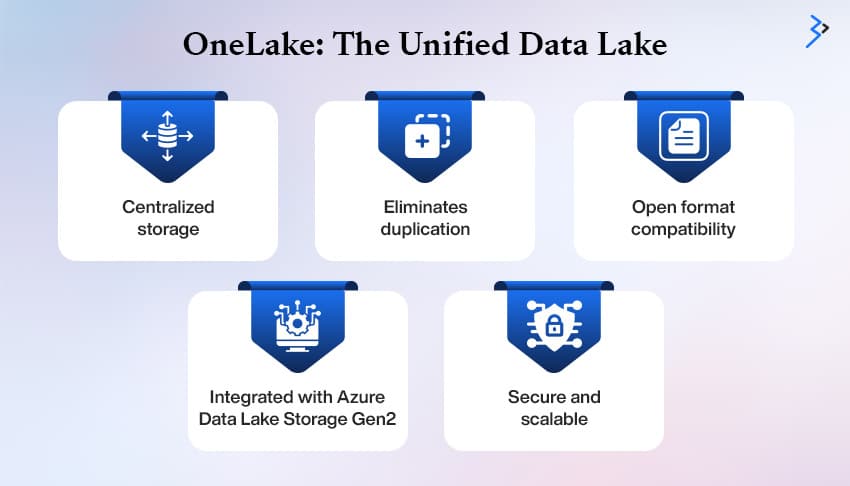
Imagine having a “OneDrive for data”—a single, accessible, and centralized repository where every byte lives in perfect harmony. That’s OneLake, the foundation of Microsoft Fabric.
- Centralized storage: No more data scattered across silos. OneLake consolidates everything in one place.
- Eliminates duplication: With a unified source of truth, data integrity is preserved and redundancies are history.
- Open format compatibility: Built on open data standards like Delta Parquet, it supports interoperability with various systems.
- Integrated with Azure Data Lake Storage Gen2: Seamlessly connects to your existing Azure ecosystem without migration hassles.
- Secure and scalable: Enterprise-grade security combined with elastic scalability means you’re always protected and prepared.
2. Data Factory: Streamlined Data Integration
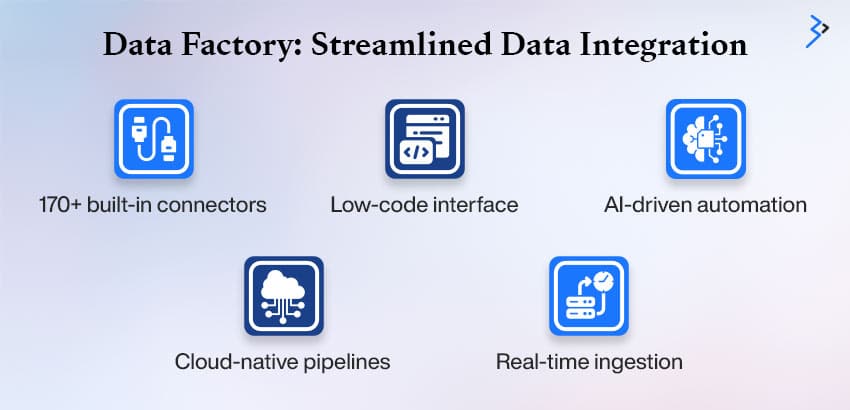
With the modern data landscape growing more chaotic by the second, Data Factory emerges as the elegant orchestrator of ingestion and transformation. It combines the best features of Azure Data Factory and Power Query in a single experience.
- 170+ built-in connectors: Easily pull data from cloud services, on-prem databases, SaaS platforms, and more with our expert Cloud Consulting Services.
- Low-code interface: Drag-and-drop workflows empower citizen developers and data engineers alike.
- AI-driven automation: Intelligent features speed up data mapping, transformation, and error detection.
- Cloud-native pipelines: Scale as your data grows without reengineering.
- Real-time ingestion: Ingest streaming data and power live dashboards effortlessly.
Whether you’re integrating CRM development services for CRM records, IoT signals, or social sentiment, Data Factory keeps it smooth and smart.

3. Synapse Data Engineering & Warehousing
Data engineering and warehousing aren’t just functions—they’re strategic capabilities. Microsoft Fabric merges Synapse Data Engineering and Synapse Data Warehousing to provide a flexible yet powerful data backend.
- Support for both structured and unstructured data: Handle everything from Excel sheets to sensor logs.
- Spark notebooks: Leverage distributed computing for advanced data transformations using Python, R, or Scala.
- SQL-based warehousing: Run complex analytics on petabytes of structured data without breaking a sweat.
- Optimized for lakehouse architecture: Get the flexibility of lakes and the performance of warehouses—all in one.
- Unified governance: Data access, security, and compliance are managed centrally.
This hybrid approach caters to both analysts and data scientists, enabling collaborative innovation.
4. Power BI Integration: Enhanced Business Intelligence
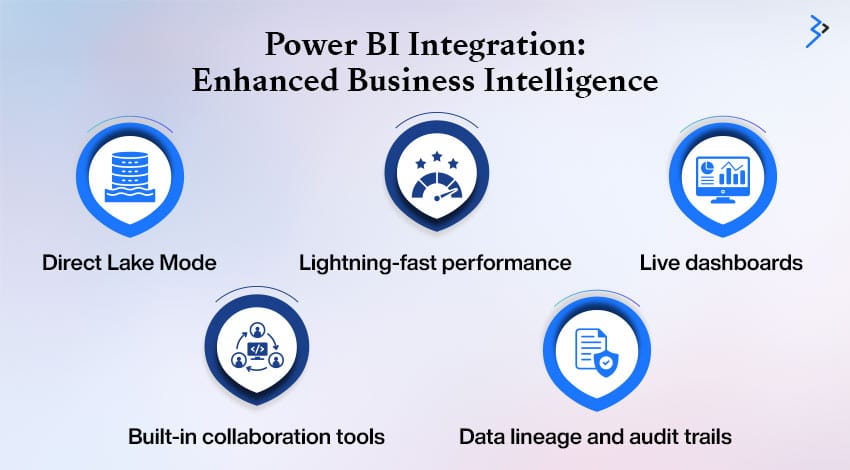
Where insights meet impact—Power BI is tightly woven into Microsoft Fabric to deliver a turbocharged BI experience.
- Direct Lake Mode: Query lakehouse data without moving or duplicating it.
- Lightning-fast performance: Dramatically reduces load times for large datasets.
- Live dashboards: Real-time data visualization for always-fresh insights.
- Built-in collaboration tools: Share reports across Teams, Outlook, and mobile devices instantly.
- Data lineage and audit trails: Full visibility into how insights are created and used.
With Fabric, Power BI isn’t just an add-on—it’s an embedded intelligence engine.
5. Copilot: AI-Powered Assistance
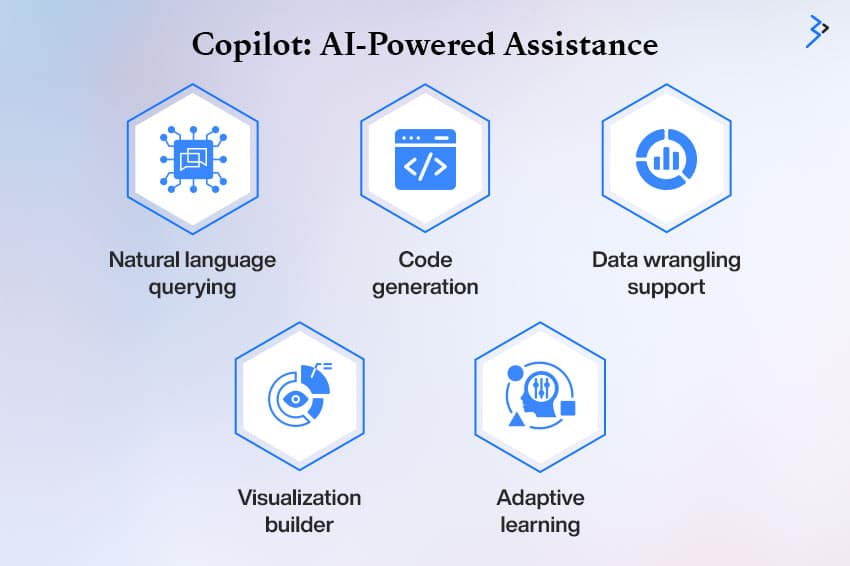
Meet your digital sidekick—Copilot, Microsoft Fabric’s generative AI assistant, designed to remove friction and supercharge productivity.
- Natural language querying: Ask questions in plain English—get insights in seconds.
- Code generation: Write Python, SQL, or DAX code with AI-assisted suggestions.
- Data wrangling support: Clean, transform, and model your data with AI-guided workflows.
- Visualization builder: Automatically generate charts, dashboards, and visuals from text prompts.
- Adaptive learning: Improves with usage, becoming more context-aware and personalized over time.
Copilot empowers both seasoned analysts and business users to do more, faster—and with fewer bottlenecks.
Read More – Harnessing Data Insights: Power BI’s Impact on the Energy Industry
Transformative Benefits of Microsoft Fabric
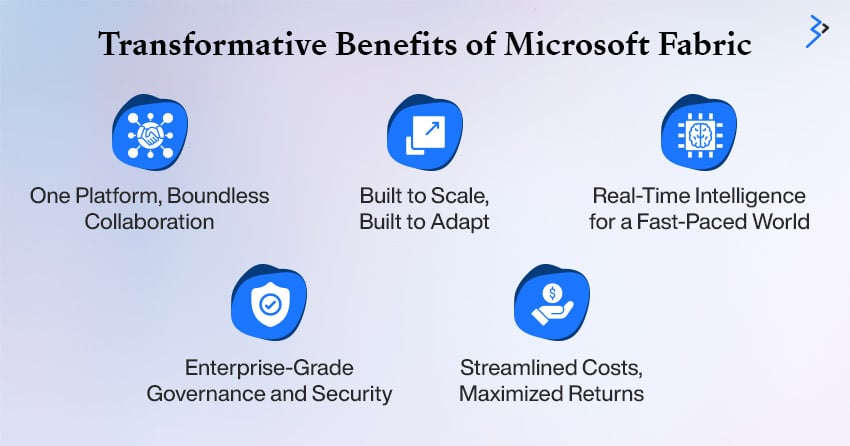
Microsoft Fabric is a turning point for businesses ready to transform the way they manage, analyze, and act on data. Designed with efficiency, scale, and intelligence at its core, Fabric addresses long-standing challenges in data analytics by delivering a unified, intelligent platform. Below, we explore the game-changing benefits that make Microsoft Fabric a must-have for forward-thinking organizations.
1. One Platform, Boundless Collaboration
Say goodbye to fragmented analytics workflows. Microsoft Fabric merges data integration, warehousing, engineering, science, and business intelligence into one cohesive platform. This isn’t just convenient—it’s transformative.
- Teams across departments can now access the same data models and analytics pipelines, eliminating silos.
- Integration with Microsoft Teams allows for real-time discussions around shared insights.
- Power BI’s deep embedding ensures visual dashboards and reports are accessible at every level of the organization.
- Azure Synapse links bring analytical power right into the decision-making process.
The result? Collaboration becomes the default, not the exception. From data scientists to marketing strategists, everyone speaks the same data language.
2. Built to Scale, Built to Adapt
Modern businesses are dynamic—and their analytics platforms need to keep up. Microsoft Fabric delivers unmatched scalability and flexibility, regardless of industry or size.
- Whether you’re processing gigabytes or petabytes, Fabric scales effortlessly.
- It supports a wide range of deployment models—cloud, on-prem, or hybrid—ensuring it fits into your unique IT strategy.
- Fabric’s modular architecture means you only use (and pay for) what you need.
Start small, grow smart. Fabric evolves with your business, handling increasing data demands without friction.
3. Real-Time Intelligence for a Fast-Paced World
Decisions can’t wait for tomorrow’s reports in industries like manufacturing, healthcare, logistics, and IoT. Our expertise as an IoT development company ensures you gain real-time insights, enabling immediate, impactful actions for critical operational needs. Microsoft Fabric’s Real-Time Hub is built for speed and precision.
- Monitor events and KPIs as they happen with streaming analytics.
- Set up automated alerts and actions using the Data Activator tool—perfect for real-time anomaly detection and operational efficiency.
- Gain actionable insights at the moment of impact, not minutes or hours later.
With Fabric, your business doesn’t just react—it anticipates and acts in real time.
4. Enterprise-Grade Governance and Security
Data security is no longer optional—it’s mission-critical. Microsoft Fabric embeds security and governance into the DNA of its platform.
- Role-based access control (RBAC) ensures the right people have access to the right data.
- End-to-end encryption protects data at rest and in transit.
- Detailed audit logs provide full transparency and support compliance with global regulations like GDPR and HIPAA.
- Centralized governance helps enforce consistent data policies across the enterprise.
This means you can unlock data without unlocking risk.
5. Streamlined Costs, Maximized Returns
With Microsoft Fabric, digital transformation doesn’t come with a towering price tag. Its SaaS model is engineered for cost-effectiveness and ROI.
- Consolidates tools—no need for multiple subscriptions or disconnected services.
- Reduces the burden on IT teams by eliminating hardware upkeep and software patching.
- Enables faster time-to-insight, accelerating data-driven decision-making and improving business outcomes.
By simplifying infrastructure and boosting efficiency, Fabric ensures your analytics investment drives tangible returns.
Real-World Applications and Success Stories
Microsoft Fabric is empowering organizations across industries to unlock the full potential of their data—enhancing efficiency, fostering innovation, and securing sensitive information. Let’s explore how two globally recognized brands, Melbourne Airport and Chanel, have achieved measurable success through strategic adoption of Microsoft Fabric.
Melbourne Airport: Enhancing Operational Efficiency and Real-Time Insights
As Australia’s second-busiest airport, Melbourne Airport faced increasing pressure to streamline operations and improve passenger experiences. To address these challenges, the airport turned to Microsoft Fabric to harness real-time insights from its growing pool of operational data.
Key Outcomes:
- 30% increase in performance efficiency across data-driven operations
- Real-time analytics enabled faster decision-making across departments
- User-friendly interface encouraged broad adoption among non-technical staff
- Cross-departmental collaboration improved due to centralized, accessible data
- Scalable solution capable of adapting to seasonal demand and airport growth
Impact:
Fabric played a pivotal role in minimizing delays and optimizing resource allocation by enabling live tracking and analysis of passenger movement, baggage flow, and flight schedules. The result? A smoother, more efficient experience for travelers and staff alike.
Chanel: Driving AI Innovation with Secure, Scalable Data Architecture
For luxury fashion icon Chanel, innovation and exclusivity go hand in hand. But in a digital-first world, that also means harnessing the power of data securely and intelligently. With Microsoft Fabric, Chanel redefined its approach to data governance, AI experimentation, and strategic agility.
Key Outcomes:
- End-to-end security and compliance ensured the protection of sensitive data.
- AI-driven insights accelerated product innovation and customer personalization.
- Data mesh architecture enabled decentralized ownership with centralized control.
- Faster decision-making across departments using unified data environments.
- Improved scalability supported Chanel’s global operations and digital initiatives.
Impact:
By breaking data silos and adopting a data mesh strategy, Chanel empowered its teams to act autonomously while maintaining trust, consistency, and oversight. Fabric enabled more agile product design, optimized supply chains, and new AI-driven marketing strategies—all without compromising on data integrity. With our Artificial Intelligence Development Services.
Why It Matters
These success stories are just the beginning. Microsoft Fabric stands out by combining ease of use with enterprise-grade capabilities, enabling:
- Global scalability across sectors like aviation, retail, healthcare, and finance.
- Integrated AI and analytics for smarter, data-backed strategies.
- Built-in governance and compliance to meet rigorous regulatory standards.
- Seamless integration with the Microsoft ecosystem, including Azure app development and Power BI.
- Faster onboarding and adoption, reducing time-to-value for enterprises.
The Future of Data Analytics with Microsoft Fabric
As organizations continue to navigate the complexities of data analytics, Microsoft Fabric stands out as a transformative solution. Its unified platform, combined with AI-driven capabilities and seamless integration with Microsoft’s ecosystem, positions it as a game-changer for businesses of all sizes. By democratizing data analytics, Fabric empowers users across the enterprise to harness the power of data, driving innovation, operational efficiency, and competitive advantage.To sum up, Microsoft Fabric is an all-encompassing platform that changes the way businesses approach data analytics; it’s not only an analytics tool. The Fabric ecosystem streamlines the analytics process and opens new opportunities for data-driven decision-making by merging data integration, engineering, logistics, science, real-time analytics, visibility, and business intelligence.
Related Articles
-
Everything You Need to Know About Embedded System Programming
Introduction Embedded systems have become a significant part of people’s lives, although they are designed to operate with little or no human intervention. They are very popular due to factors
-
Advantage of being a Microsoft Gold Partner
While many people worry about the downsides of being a Microsoft gold partner, the fact is that there are plenty of advantages to being a Microsoft Gold Partner. A Microsoft
-
Microsoft 365: The All-in-One Productivity Suite
Introduction In today’s digital world, businesses and individuals alike are constantly seeking ways to enhance their productivity and streamline their workflows. Enter Microsoft 365, a comprehensive suite of cloud-based productivity

